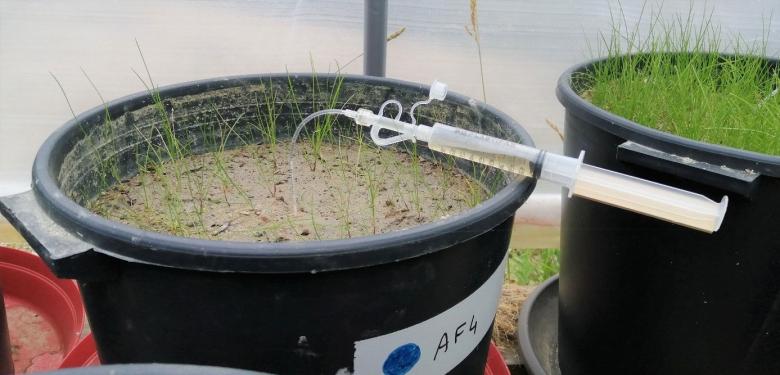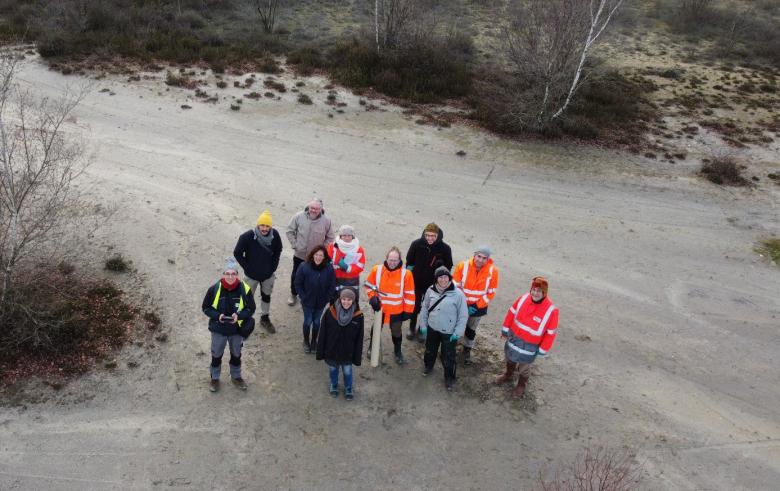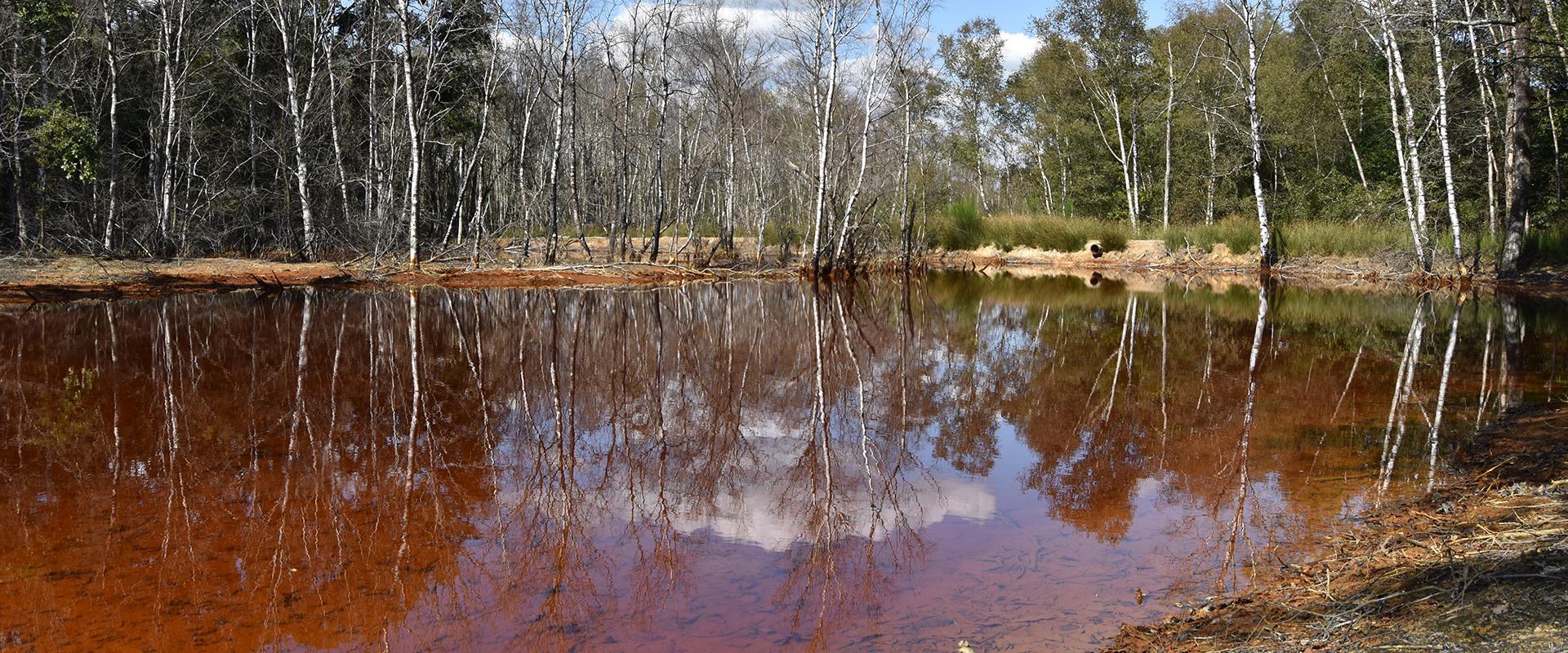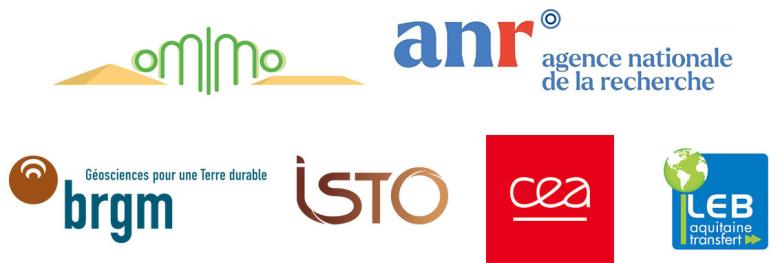
oMIMo project, sampling of pore water in the tailings of a tin mine during a phytostabilisation experiment (PRIME platform, 2023)
© BRGM
Issues and needs
The aim of the oMIMo project (2023-2027), "Optimisation of phytostabilisation strategies for arsenic-rich mining waste: prediction of impacts on water and the bio-availability of pollutants for plants in relation to microbial activities", is to develop a predictive model of impacts on water and the bio-availability of pollutants for plants in relation to microbial activities in phytostabilised mining tailings.
Securing tailings from mining operations is a major environmental challenge. Most metal mines produced waste containing iron (Fe) and sulphur (S), with the toxic element arsenic (As) included at more than 50% of sites. Phytostabilisation often appears to be an appropriate option for minimising the risks associated with the dispersion of particles through erosion, at a reasonable cost. However, its inclusion in rehabilitation projects by site managers needs to be backed up by a quantitative assessment of its effect on the fate of As and metals in waste masses.
There is a real economic potential for developing phytostabilisation as an operational option for managing mine waste dumps, as a short- and medium-term objective. In line with the French national methodology for the management of contaminated ground, the results of the project will be used to:
- improve a site's conceptual model for assessing transfers,
- reduce uncertainties about the effectiveness of phytostabilisation,
- enable a better cost-benefit analysis, with in particular an assessment of source stability, long-term evolution, technological readiness and the creation of ecosystem services,
- ensure that the project's objectives are achieved by choosing the most appropriate strategies.
The availability of economically realistic management strategies, such as phytostabilisation, for many currently orphaned landfill sites should help to improve the economic health of a large number of regions.
The aim of oMIMo is to develop a tool for predicting the mobility of As and metals and their availability to plants in arsenic-contaminated phytostabilised mine waste, based on a reactive transport modelling (RTM) methodology incorporating microbial parameters. oMIMo will meet the need to predict impacts, including arsenic and metal infiltration flows, when phytostabilisation is developed as an operational option in mining areas. The project will provide a modelling methodology accompanied by recommendations, including the type of relevant analyses (geochemical, mineralogical and biological) to be carried out for the numerical determination of the medium- and long-term evolution of As and metal flows.

The project team visiting the mining site chosen for the oMIMo trials (Loire Atlantique, December 2022)
© BRGM
Expected results
oMIMo, through the development of a model that takes into account spatial and temporal biogeochemical phenomena, will address the uncertainties inherent in the evolution of As and metal flows in phytostabilised mine tailings. This objective is being addressed by the oMIMo consortium through an interdisciplinary approach combining geochemistry, numerical modelling, plant physiology, microbiology and omics approaches with sound operational knowledge of the management of former mining sites.
The oMIMo methodology is based on a controlled scenario of assisted phytostabilisation, developed up to a metric pilot and for which a first version of the RTM was developed for arsenic residues from a silver (Ag) and lead (Pb) mine. oMIMo proposes to integrate into the RTM, data indicative of active microbial processes linked to the metabolisms of As, Fe and S, obtained during two experiments carried out in BRGM's PRIME platform over a period of 2 years:
- A mesocosm was filled with 1,200 kg of residue from a tin (Sn) mine in March 2023. This pilot experiment reproduces on a metric scale the different compartments of the deposit: phytostabilised surface, underlying unsaturated zone, then saturated zone.
- Sub-metric experiments in 20 L pots started at the beginning of May 2023 with 2 types of tailings, from the Ag-Pb mine and arsenic tailings from the Sn mine. The plant species chosen for these trials was Festuca rubra, and the mine tailings were amended with a mixture of limestone and compost, in the area colonised by the plants.
These experiments will provide precise data on the evolution of geochemistry, microbial processes and the bioavailability/toxicity of As and metals for plants. The RTM will be based on a mass balance and thermodynamic laws. A network of stoichiometric metabolic reactions will represent the redox sequence suspected of occurring in the tailings, feeding an initial version of the model with state-of-the-art and initial geochemical data from metric and sub-metric experiments.
In the second version of the model, this formalism will be enriched to simulate controlled thermokinetic reactions and to couple microbial metabolisms with abiotic geochemical processes. The reaction network will be corrected by identifying the active bacteria using 16S rRNA sequencing from the sub-metric experiments, followed by omics data (metagenomics and metaproteomics) from the metric experiment.
For each metabolism detected, the thermodynamic term will be coupled to a Monod equation, the biomass component of which will be linked to a growth function for each metabolic group. The parameters of these functions will first be estimated by determining the abundance (by MPN, Most Probable Number) of bacteria in the metabolic groups of interest. Omics data will provide a more accurate picture of active metabolisms and their distribution from the surface to the water-saturated zone.
A third version of the model will incorporate transport parameters. The calculated data will be compared with water geochemistry measurements and plant bio-indicators (stress levels and pollutant concentrations) for the surface compartment.
BRGM’s role
As part of the oMIMo project, BRGM is coordinating the scientific, administrative and communication aspects. BRGM hosts and contributes to the implementation of experiments in pots and mesocosms, and supervises the building of models. BRGM has been entrusted by the State with operational responsibility for the majority of former mining sites in France through its specialised Department of Mining Safety and Risk Prevention (DPSM - Direction de la Sécurité Minière et de la Prévention des Risques). The DPSM is directly involved in carrying out the project, through the management of on-site missions and the exchange of information and data acquired on the phytostabilised plots in situ and from the oMIMo experiments.






